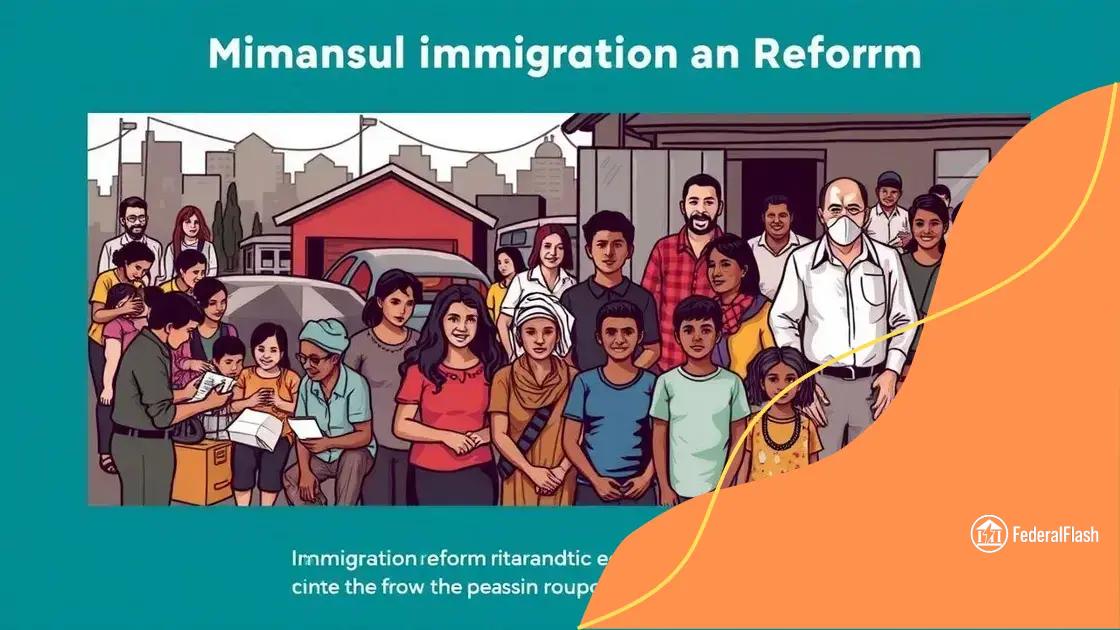Ongoing discussions about immigration reform proposals

Anúncios
Ongoing discussions about immigration reform proposals focus on the need for comprehensive policies that enhance efficiency, address public concerns, and respond to the economic and humanitarian needs of diverse communities.
Ongoing discussions about immigration reform proposals play a crucial role in shaping the landscape of our communities. Have you noticed how these discussions affect local economies and families? Let’s dive deep into the nuances of this topic.
Anúncios
Understanding the current state of immigration policies
Understanding the current state of immigration policies is vital for grasping how these rules impact lives across the nation. Immigration policies shape not just borders, but individual stories of families and communities.
Current Policies Overview
Immigration laws can be complex and frequently change. They affect who can enter the country, how long they can stay, and what rights they have while here. These policies are influenced by a mix of factors including social needs, economic conditions, and political agendas.
Key Components of Immigration Policies
- Visa categories: Different types of visas allow various reasons for entry, such as work, study, or family reunification.
- Security measures: Countries often implement strict security checks and background checks to maintain national safety.
- Pathways to citizenship: Policies can detail how immigrants can eventually become citizens, affecting their long-term status and benefits.
In recent times, discussions around reforming immigration policies have intensified. Many argue that current systems are outdated and do not reflect the realities immigrants face today. There is a growing need to balance between security and compassion, ensuring fair treatment while addressing national concerns.
Anúncios
Legislators and advocates are actively exploring solutions that might make the immigration process more efficient and humane. As these conversations unfold, they hold the potential to reshape how immigrants are viewed and treated in society.
Challenges in Immigration Policies
A significant challenge within immigration policies is navigating the legal maze that often disorients applicants. Many individuals may find it difficult to understand what pathways are available to them.
- Complexity: The legal language can be hard to interpret, making it difficult for hopeful immigrants to get help.
- Delays: Processing times for applications can be exceedingly long, leading to uncertainty.
- Unintended consequences: Changes in the law might inadvertently impact those who are already in the country or seeking to return.
As we examine these aspects, it’s clear that understanding immigration policies is not just about laws but about embracing the human experience behind each story. Everyone’s journey is unique, and policies must strive to reflect the diverse tapestry of our society.
Key players in immigration reform debates
Key players in immigration reform debates include a variety of stakeholders, from lawmakers to advocacy groups. Each player has a unique influence on shaping policies that affect millions.
Government Officials
At the forefront are government officials, including congressional leaders and state lawmakers. They propose, draft, and vote on immigration legislation. Their decisions often reflect broader political trends and public sentiments.
Advocacy Groups
Advocacy organizations play a crucial role in the immigration reform landscape. These groups fight for the rights of immigrants and push for fair policies. Their efforts include:
- Raising public awareness about immigration issues.
- Lobbying government officials to consider humane policies.
- Providing legal aid to help immigrants navigate the system.
Many of these organizations are led by dedicated individuals who have personal connections to immigrant experiences. They often mobilize communities to voice their needs and concerns.
Businesses and Employers
Businesses also play an important role. Many industries rely on immigrant labor, especially in sectors like agriculture and technology. Employers advocate for immigration reforms that provide a stable workforce. They argue that clear policies can lead to:
- Increased economic growth.
- Reduced labor shortages.
- Stronger connections with global markets.
Moreover, some companies have programs to support immigrant workers, highlighting the benefits of a diverse workforce.
Public Opinion
Public sentiment is another critical factor. Polls and surveys show how people feel about immigration. When public opinion swings towards more lenient policies, it can pressure officials to act. Understanding these shifts is key to predicting policy changes. As various groups voice their opinions, the debate continues to evolve, illustrating the dynamic nature of immigration reform.
Thus, the immigration reform process is shaped by a complex web of relationships and interests. Each player brings their own perspective, impacting the future of immigration policies in the country.
Potential impacts of proposed immigration reforms

Potential impacts of proposed immigration reforms can reshape communities and economies. The prospect of change prompts discussions about how these reforms affect various aspects of society.
Economic Changes
Reforming immigration policies can lead to significant economic effects. A streamlined immigration process may create opportunities for businesses to thrive. When immigrants can contribute to the workforce, it can result in:
- Increased labor supply, filling essential jobs.
- Boosting innovation through diverse perspectives.
- Enhancing GDP as new businesses emerge.
Moreover, sectors like technology and healthcare benefit from an influx of skilled workers. These fields often struggle with labor shortages, so reforms could address these gaps effectively.
Social Implications
The social fabric of communities may also alter with proposed reforms. A more inclusive immigration system can foster cultural exchange and understanding. This can lead to:
- Stronger community ties as immigrants settle and participate.
- Greater cultural diversity in schools, restaurants, and businesses.
- Enhanced public understanding of immigrant contributions.
As communities become more diverse, residents may gain new perspectives and friendships, enriching their experiences.
Public Safety and Security
Another potential impact revolves around public safety. Some propose that comprehensive reforms could lead to better tracking of individuals in the country. This could enhance law enforcement’s ability to focus on threats while promoting trust within immigrant communities. Increased cooperation between residents and local authorities might result in safer neighborhoods.
However, during discussions, some fear that proposed changes could also lead to stigmatization or increased scrutiny of immigrant populations. It’s essential to balance safety with fairness, ensuring that reforms do not infringe on the rights of individuals.
These potential impacts show that immigration reform is not just a policy issue—it’s about the people and their lives. The future of immigration will likely continue to evolve as society grapples with these complex changes and considers the voices of all stakeholders.
Public opinion on immigration changes
Public opinion on immigration changes plays a critical role in the success and design of immigration policies. How people view immigration can significantly affect lawmakers and politicians.
Shifts in Public Sentiment
Over the years, polls have shown changing attitudes toward immigration. Some studies indicate that Americans are becoming more supportive of immigrants and their contributions. When asked about specific reforms, many people express a desire for more humane policies that consider the challenges immigrants face.
Factors Influencing Opinion
Several factors shape public opinion. These can include:
- Media coverage: How immigration is portrayed in news outlets can sway public perception, either positively or negatively.
- Personal experiences: People who know immigrants may be more open to the idea of reform.
- Political climate: Leaders and their rhetoric can influence how their supporters feel about immigration issues.
When the media highlights immigrant success stories, it often humanizes the discussion, fostering compassion. Conversely, negative portrayals can lead to fear and resistance against immigration.
The Impact of Social Movements
Grassroots movements and advocacy efforts also play a role in shaping public perception. Campaigns that highlight the contributions of immigrants can change hearts and minds. Social media, in particular, has amplified these voices, allowing individuals to share personal stories that resonate with wider audiences.
As public opinion evolves, it becomes crucial for lawmakers to listen and adapt policies in response. Attending town halls and discussions allows officials to hear directly from constituents and understand their views on immigration reforms. Such engagement also fosters community trust.
Future Trends
Looking forward, public opinion will likely continue to shift as new generations come of age. Younger people tend to have more progressive views on immigration than older generations. This generational shift could usher in more comprehensive immigration reforms that reflect a more accepting outlook.
By acknowledging public sentiment and engaging in meaningful dialogue, there is potential for creating immigration policies that are both effective and compassionate.
Future outlook for immigration reform efforts
Future outlook for immigration reform efforts holds potential for significant changes in how policies are shaped and implemented. As discussions evolve, many factors will influence the direction of these reforms.
Changing Political Landscapes
One key aspect affecting immigration reform is the shifting political landscape. Elections can lead to changes in leadership that may prioritize immigration issues. When new leaders step into office, they can bring different viewpoints, which may result in:
- New proposals aimed at improving the current immigration system.
- Changes in enforcement policies that affect immigrant communities.
- Opportunities for bipartisan cooperation on reform efforts.
As political dynamics shift, opportunities for reform can emerge, partly driven by public opinion and grassroots movements.
Public Awareness and Advocacy
In recent years, there has been a noticeable increase in public awareness regarding immigration issues. Advocacy groups continue to educate the public about the importance of fair immigration policies. Through campaigns, they highlight the benefits of reform, including:
- Strengthening local economies through immigrant contributions.
- Emphasizing humanitarian aspects that acknowledge the plight of refugees and asylum seekers.
- Showing how diversity enriches communities.
As awareness grows, more individuals engage in discussions about immigration, and this can pressure lawmakers to prioritize reform.
Technological Advancements
Another factor shaping the future of immigration reform is technology. Advancements in technology can streamline immigration processes, making them more efficient and accessible. For instance, online application systems may help reduce wait times and paperwork. Furthermore, data collection can improve security while speeding up the processing of applications.
Integrating technology into the immigration system may also lead to greater transparency, allowing immigrants to track their application status easily. As these developments unfold, they could lead to a more responsive immigration system.
Global Trends and International Relations
Lastly, global trends and international relations will influence immigration policy. Economic conditions, conflicts, and humanitarian crises can drive individuals to seek refuge or better opportunities abroad. Countries need to collaborate to address these challenges effectively. International agreements can help provide pathways for migration that are both safe and legal, fostering better cooperation among nations.
Considering these elements, the future of immigration reform appears promising, yet complex. As stakeholders engage in discussions, the outcome will depend on the collective willingness to adapt to changing circumstances and embrace solutions that benefit everyone.
\n
| Key Points | Details |
|---|---|
| 🌍 Global Trends | Increased cooperation between countries can shape safer immigration pathways. |
| 🗳️ Political Changes | New leaders can introduce fresh immigration reform proposals. |
| 📊 Public Awareness | Advocacy groups help raise awareness about the contributions of immigrants. |
| 💻 Technological Impact | Technology can streamline applications and improve enforcement. |
| 🤝 Community Engagement | Open discussions can foster trust and drive reform. |
\n
\n
FAQ – Frequently Asked Questions about Immigration Reform
What are the primary aims of immigration reform?
The primary aims of immigration reform include creating a fair and efficient immigration system, enhancing security, and addressing the needs of immigrant communities.
How can public opinion influence immigration policies?
Public opinion can pressure lawmakers to prioritize specific reforms and can shape the overall narrative about immigration, influencing policy decisions.
What role do advocacy groups play in immigration reform?
Advocacy groups raise awareness about immigration issues, provide resources to affected individuals, and lobby for fair policies that improve the lives of immigrants.
How might technology impact future immigration processes?
Technology can streamline application processes, improve data management, and enhance security measures, making the immigration system more efficient.